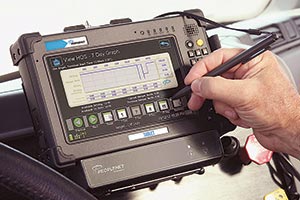US Issues Final ELD Rule

The Federal Motor Carrier Safety Administration last week announced its long-awaited final rule that will require carriers to use electronic logging devices to record drivers’ hours of service.
The 516-page rule details new technical specifications for ELDs, clarifies supporting-document requirements and includes measures aimed at ensuring that ELDs are not used to harass drivers.
“Today is truly a historic day for trucking,” said Bill Graves, president of American Trucking Associations. “This regulation will change the trucking industry — for the better — forever.”
Carriers will have two years to comply with the mandate after its publication in the Federal Register, expected shortly after this edition went to press, meaning the deadline for compliance would be December 2017.
“Since 1938, complex, on-duty/off-duty logs for truck and bus drivers were made with pencil and paper, virtually impossible to verify,” Transportation Secretary Anthony Foxx said. “This automated technology not only brings logging records into the modern age, it also allows roadside safety inspectors to unmask violations of federal law that put lives at risk.”
Industry analysts and ELD suppliers expect the mandate to dramatically accelerate the industry’s adoption of onboard technology, with some carriers focusing only on basic compliance while others look for additional features to improve efficiency.
The final rule permits the use of smartphones as ELDs if they are certified and listed on an agency website.
Carriers who previously installed compliant automatic on¬board recording devices may continue to use those devices for an additional two years beyond the compliance date. An AOBRD is a device capable of recording a duty status automatically as defined by earlier agency regulations.
Canada- and Mexico-domiciled drivers also will be required to use ELDs when operating on U.S. roadways.
FMCSA said the final ELD rule will result in an annual net benefit of more than $1 billion for the industry — largely by reducing the amount of required paperwork.
Collin Mooney, acting executive director of the Commercial Vehicle Safety Alliance, said his group supports the rule but is reaching out to its state law enforcement partners to determine if the two permitted methods — wireless Web services and e-mail or Bluetooth and USB 2.0 — of transferring hours data from the truck cab to roadside inspectors are sufficient.
For safety reasons, officers do not enter truck cabs, so getting a good view of the ELD data display could be problematic for inspections of vehicles without ELD printers or located in cellular dead zones, Mooney said.
Several industry groups voiced concern with the rule.
Norita Taylor, a spokeswoman for the Owner-Operator Independent Drivers Association, said OOIDA is waiting to see how the rule plays out in terms of driver harassment.
“We know of no technology that automatically tracks a driver’s record of duty status, and so ELDs will not be able to verify compliance with hours-of-service regulations,” Taylor said.
The Truck Renting and Leasing Association said it had concerns that the rule does not exempt rental trucks from using ELDs.
“Even though the vast majority of Trala member customers would be exempt from the rules [due to the 100-mile and 150-mile radius exemptions] a certain percentage of those customers are mandated currently by HOS regulations,” Trala said.
Other provisions in the rule exempt drivers who use paper logs for not more than eight days during any 30-day period, who conduct drive-away/tow-away operations or drive vehicles manufactured before 2000.
Among the examples of supporting documents included in the rule are bills of lading, itineraries or similar documents that indicate the origin and destination of each trip.
The final rule also lowers to eight from 10 the number of maximum supporting documents to be retained and increases the timeframe to 13 days from eight days in which a driver must submit them to his or her employer.
Analyst Clem Driscoll described the federal ELD rule as perhaps the most significant event in the history of commercial-vehicle telematics.
He said the mandate will necessitate rapid adoption of ELDs through late 2017 since a majority of trucks on the road are not yet equipped with the technology.
Beyond 2017, the telematics market will shift to upgrades and added services, in large part for smaller trucking companies that start out with a basic ELD product but then seek to get more out of their onboard technology, Driscoll predicted.
Although industry suppliers had little time to review the details of the final rule before Transport Topics’ deadline, ELD makers contacted for this story said they generally expect to bring their current systems into compliance with the rule through software updates.
At first glance, “nothing’s really alarming” about the final rule, said Elise Chianelli, director of safety and compliance at PeopleNet.
She said the data-transfer options and the exemption for model year 2000 and older trucks without electronic control modules eased some concerns about the rule.
Chianelli said different carriers will adopt different types of ELD products, with some just complying with the mandate and others looking for more opportunities for a return on investment though applications such as fuel-mileage tracking, vehicle-location monitoring, dispatch and onboard navigation.
Tom Cuthbertson, vice president of regulatory affairs at Omnitracs, said some potential benefits of onboard technology, such as fuel management and engine-fault reporting, can benefit fleets of all sizes.
“I would advise people to take a look at the other features and functions out there that can help you manage your fleet,” he said.
He also recommended that first-time adopters give themselves adequate time to implement ELDs correctly.
Fred Fakkama, vice president of compliance at Zonar Systems, offered a similar warning.
“Getting a fleet and its drivers to switch from paper logs to a technology they may not be familiar with has an inherent learning curve,” he said in a Dec. 10 statement.
“I think the industry has been looking for clarity on this issue for a long time, and now we can move forward,” said Rustin Keller, chief operating officer at J.J. Keller & Associates, which offers an ELD product that runs on smart devices. “We were pleased to see that FMCSA has expressly allowed mobile devices, which J.J. Keller views as critical to offering a low-cost and flexible option for e-logging.”
The ELD mandate “will really help the industry move forward in terms of increasing compliance to the hours-of-service rule while also helping to solve productivity issues linked to detention time,” said Alex Capelle, ELD program manager for Continental Corp., which offers an electronic product called VDO RoadLog.
Skip Kinford, CEO of the Americas at MiX Telematics, said the ELD rule will lead to safer roads and a “level playing field on compliance so there’s no competitive advantage” among carriers.




